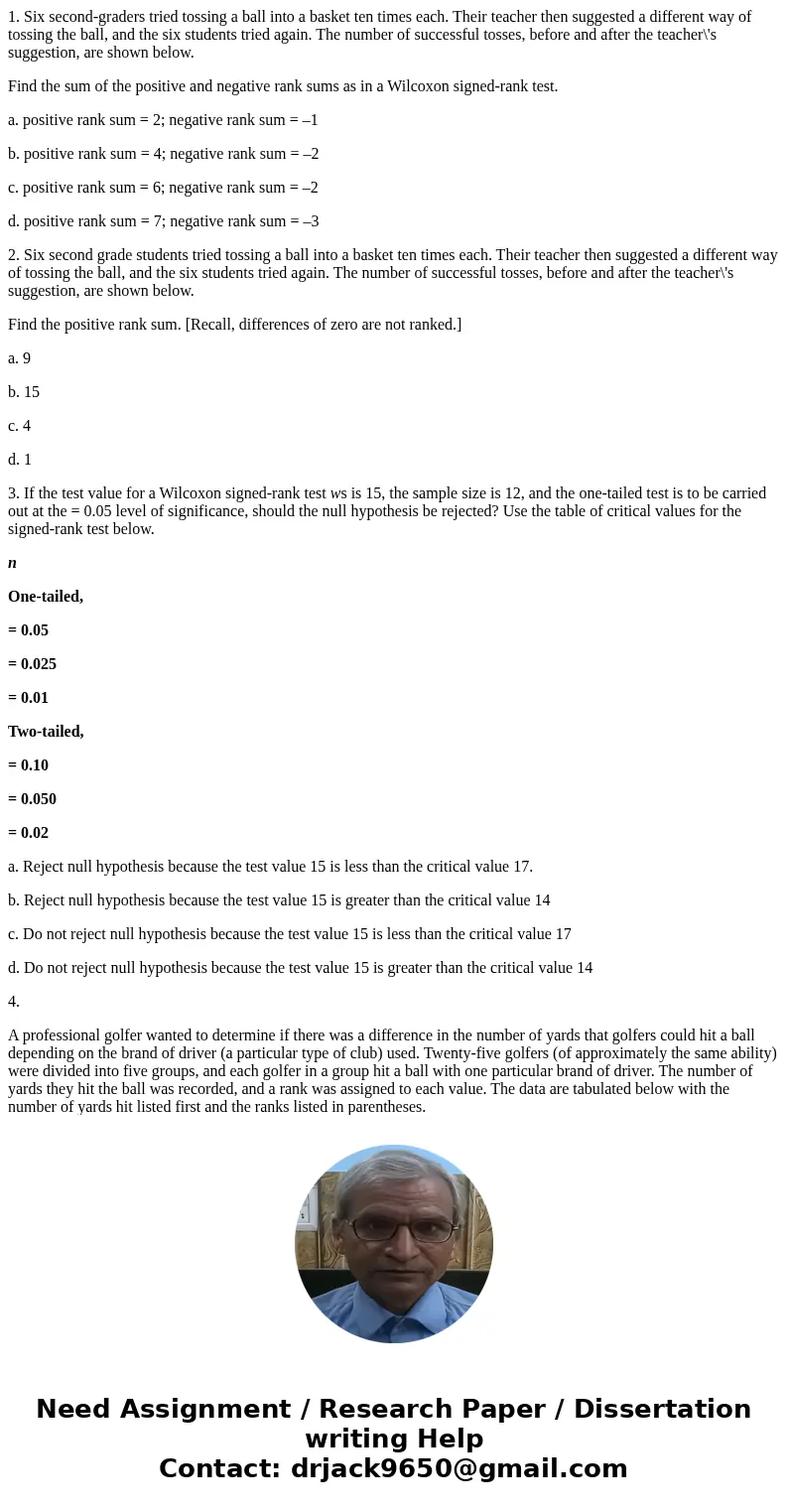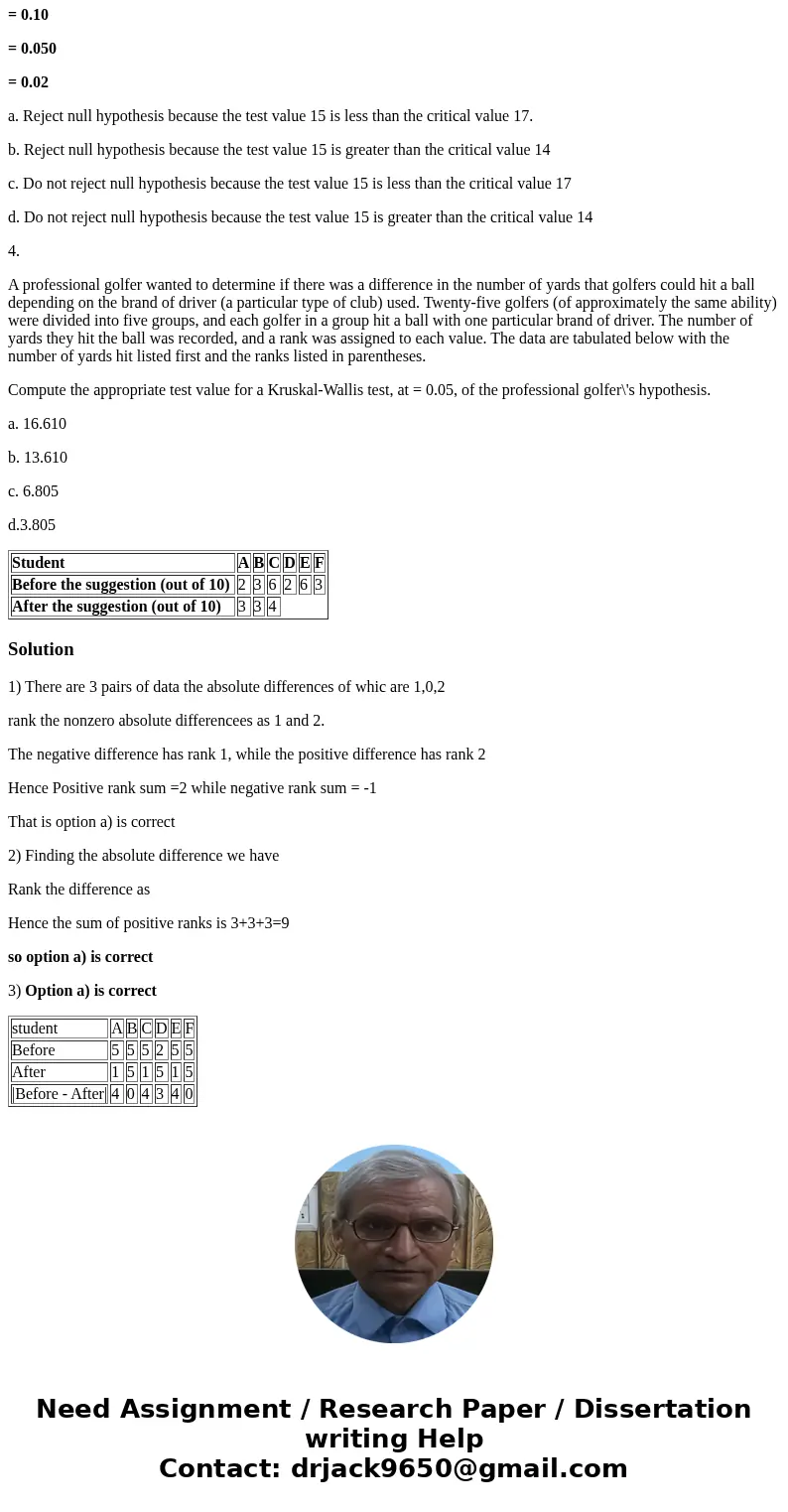1 Six secondgraders tried tossing a ball into a basket ten t
1. Six second-graders tried tossing a ball into a basket ten times each. Their teacher then suggested a different way of tossing the ball, and the six students tried again. The number of successful tosses, before and after the teacher\'s suggestion, are shown below.
Find the sum of the positive and negative rank sums as in a Wilcoxon signed-rank test.
a. positive rank sum = 2; negative rank sum = –1
b. positive rank sum = 4; negative rank sum = –2
c. positive rank sum = 6; negative rank sum = –2
d. positive rank sum = 7; negative rank sum = –3
2. Six second grade students tried tossing a ball into a basket ten times each. Their teacher then suggested a different way of tossing the ball, and the six students tried again. The number of successful tosses, before and after the teacher\'s suggestion, are shown below.
Find the positive rank sum. [Recall, differences of zero are not ranked.]
a. 9
b. 15
c. 4
d. 1
3. If the test value for a Wilcoxon signed-rank test ws is 15, the sample size is 12, and the one-tailed test is to be carried out at the = 0.05 level of significance, should the null hypothesis be rejected? Use the table of critical values for the signed-rank test below.
n
One-tailed,
= 0.05
= 0.025
= 0.01
Two-tailed,
= 0.10
= 0.050
= 0.02
a. Reject null hypothesis because the test value 15 is less than the critical value 17.
b. Reject null hypothesis because the test value 15 is greater than the critical value 14
c. Do not reject null hypothesis because the test value 15 is less than the critical value 17
d. Do not reject null hypothesis because the test value 15 is greater than the critical value 14
4.
A professional golfer wanted to determine if there was a difference in the number of yards that golfers could hit a ball depending on the brand of driver (a particular type of club) used. Twenty-five golfers (of approximately the same ability) were divided into five groups, and each golfer in a group hit a ball with one particular brand of driver. The number of yards they hit the ball was recorded, and a rank was assigned to each value. The data are tabulated below with the number of yards hit listed first and the ranks listed in parentheses.
Compute the appropriate test value for a Kruskal-Wallis test, at = 0.05, of the professional golfer\'s hypothesis.
a. 16.610
b. 13.610
c. 6.805
d.3.805
| Student | A | B | C | D | E | F |
| Before the suggestion (out of 10) | 2 | 3 | 6 | 2 | 6 | 3 |
| After the suggestion (out of 10) | 3 | 3 | 4 |
Solution
1) There are 3 pairs of data the absolute differences of whic are 1,0,2
rank the nonzero absolute differencees as 1 and 2.
The negative difference has rank 1, while the positive difference has rank 2
Hence Positive rank sum =2 while negative rank sum = -1
That is option a) is correct
2) Finding the absolute difference we have
Rank the difference as
Hence the sum of positive ranks is 3+3+3=9
so option a) is correct
3) Option a) is correct
| student | A | B | C | D | E | F |
| Before | 5 | 5 | 5 | 2 | 5 | 5 |
| After | 1 | 5 | 1 | 5 | 1 | 5 |
| |Before - After| | 4 | 0 | 4 | 3 | 4 | 0 |


 Homework Sourse
Homework Sourse